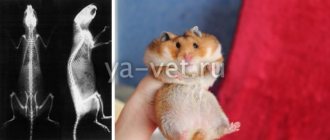A hamster is a tiny animal that masterfully attracts your attention and evokes affection: the way it sleeps, eats, plays, you want to pick it up and feel this warm fluffy lump in your palm. Place a wheel in the cage, attach pipe tunnels to the cage, place the hamster in a walking ball - this pet will amaze everyone with its mobility, agility and endurance.
For normal growth and development, a hamster requires carbohydrates, proteins, fats, vitamin and mineral complexes and clean water. If necessary, veterinary specialists-ratologists in the veterinary department will help you choose the appropriate diet for your pet, taking into account the needs and depending on the time of year. Of course, you can do this yourself at home, but it is necessary to take into account that the food must be fresh and varied, containing not only plant components, but also components of animal origin. And for normal functioning of the gastrointestinal tract and complete wiping and grinding of teeth, the diet must contain coarse fibers, twigs and special treats.
Diseases of hamsters - oral cavity and skin
Boils. Hamster diseases
Hamster abscesses are a type of abrasion that appears mainly on the pads of hamsters' feet.
- reasons - the exact cause of the appearance of abscesses has not been found, but veterinarians are inclined to mechanical injuries;
- symptoms - the presence of abrasions on the pet’s paws, which are detected during a visual examination of the hamster;
- treatment - most often, to eliminate abscesses in hamsters, doctors prescribe the use of ointments with zinc or fish oil, or preparations based on these components. Treatment of such a seemingly minor disease can take several months, since the pads are very sensitive and are constantly exposed to stress.
Anomalies of teeth. Hamster diseases
Anomalies of teeth in hamsters - all representatives of rodents have such a feature as the constant growth of their front teeth. Because of this, the animal’s bite may be disrupted and the teeth simply do not close. This already leads to digestive disorders, etc.
- reasons - the cause of such anomalies may be genetic characteristics that imply accelerated tooth growth, or the cause may be a diet that contains very little solid food. The animal simply does not have time to grind down its teeth;
- Diseases of hamsters often spread to the teeth; the most common symptoms of dental pathologies are increased salivation. The pet may refuse food, stop gnawing food;
- treatment - to cure this type of pathology, you should not self-medicate, but seek help from a veterinarian. Often a procedure such as treating teeth with a drill is performed. If “hooks” appear on the teeth as a result of the disease, they should also be removed.
Inflammation of the cheek pouches. Hamster diseases
- reasons - inflammation of the sacs occurs if there is any damage to them on the inside. Also, if food is constantly stored there, an inflammatory process may occur due to the interaction of tissues and fibers of the products;
- symptoms - as a rule, symptoms of inflammation of the cheek pouches may be absent at all. But there may also be a decrease in appetite due to painful sensations;
- treatment - it is possible to fix the inflammation only by contacting a veterinary center, since to examine the cheeks from the inside you need to turn them out correctly. If you do not have the necessary skills, you can cause discomfort to your pet. Inflammation is treated by removing remaining food and treating with bactericidal agents.
Hair loss in hamsters
Baldness in hamsters may be confused by some owners with lichen, since they are very similar upon visual inspection. The only difference
, which can clarify the picture is the presence of scales in areas of hair loss in cases of lichen, while in cases of baldness the skin remains smooth. You should not diagnose yourself; in any case, you should consult a veterinarian.
- reasons - the causes of baldness in hamsters include the following factors: a decrease in the intake of vitamins and minerals in the body, frequent and severe stress in the pet;
- symptoms - symptoms manifest themselves in hair loss, you can also notice apathy and lethargy in your pet;
- treatment - if there is a lack of vitamins, they should be included in the hamster’s diet. If there is stress, it is necessary to exclude its occurrence.
Herpes in hamsters
Herpes in hamsters is an inflammation of the skin near the mucous tissues of the animal.
- reasons - a hamster can become infected with herpes through contact with other hamsters;
- symptoms - the disease occurs without any visible symptoms. It can be detected more often only during routine veterinary examinations;
- treatment - this disease does not require special treatment and goes away on its own in one to two weeks, but in any case, consultation with a specialist is necessary to know exactly what ailment your pet has.
Trichomonosis. Hamster diseases.
Trichomoniasis in hamsters is a disease caused by the activity of a parasite from the Trichomonas gallinae family.
- reasons - the parasite can enter your hamster’s body by drinking dirty water or bad food. Due to weak immunity, young people are especially more susceptible to trichomoniasis than adults;
- symptoms - manifested in a yellowish tint of the pharynx. Subsequently, it increases in size, as if it swells and blocks access to oxygen;
- treatment - carried out through the use of medications that should only be prescribed by a veterinarian. If you do not help your hamster in time, death is possible.
Conjunctivitis in hamsters
Conjunctivitis is also a disease of hamsters; it is a pathology associated with disruption of the mucous membrane of the eyes.
- causes - bacterial infections or colds that cause complications;
- symptoms - there may be copious discharge of mucus from the eyes;
- treatment - doctors recommend rinsing the eye mucosa with salt water or using special drops.
Types of tumors
The bumps can be located both internally (on organs) and externally (on and under the skin). Based on the nature of their development, three groups of neoplasms are distinguished.
Benign
Their appearance provokes unlimited cell division caused by injury, virus, or failure at the level of the genetic code. These neoplasms are characterized by stability. They look like a small subcutaneous ball. When you press on it, it moves to the side. Their density varies: hard, soft, similar to cartilage. They must be removed so that they do not turn malignant.
Important! Typically located on the abdomen, armpits and groin. Quite rarely found on the head.
Malignant
They appear immediately as malignant or transform over time from benign. Cell division in them occurs intensively and in all directions, so metastases occur in different places. The cause of their appearance may be viruses, a disrupted diet, or a failure at the genetic level. Most often they are found in hard-to-reach places of the body and threaten the life of the pet.
Inflamed tissue
The inflamed area looks like a slight swelling. It does not arise due to cell division and tissue proliferation. Most often it appears due to the accumulation of pus (abscess) or lymph.
Did you know? Since 2008, Vietnam has banned keeping hamsters at home, as they are believed to be carriers of dangerous diseases.
Digestive diseases in hamsters
Obesity in hamsters
Obesity in a hamster - an increase in the amount of subcutaneous fat in a hamster can have a bad effect on other organs, such as the heart. By nature, the hamster is a mobile animal and needs constant exercise.
- reasons - a decrease in physical activity, often due to the fault of the owner, when living conditions do not meet the requirements;
- symptoms - a visual increase in the fat layer in the hamster. Decreased overall activity
- treatment - increasing the load, installing various treadmills and attractions in the cage. Monitoring caloric intake.
Colibacillosis. Hamster diseases
Colibacillosis in a hamster is a disease of the gastrointestinal tract, which manifests itself in its disorder. Also, this disease is called “ wet tail ”. It has a bacterial origin. This intestinal pathology can confuse owners
, since in the early stages it is similar to other diseases that are not of a bacterial nature.
- reasons - the presence of unfavorable bacteria in the body, which come from food or water;
- symptoms - the main sign is the presence of diarrhea in a hamster. Subsequently, lack of appetite, water diarrhea, aggressive conditions, bleeding are connected;
- treatment - colibacillosis can be cured only by following all the instructions and recommendations of a veterinarian. Most often, solutions containing electrolytes are used to improve the hydration process. Along with this, antibiotics are prescribed that stabilize the condition of the intestines. It is also necessary to adhere to a certain diet, which involves excluding certain foods from the diet.
Important! Colibacillosis can be transmitted to other individuals. Therefore, if you have other hamsters, they must be isolated from the infected pet.
E. coli is also a disease of hamsters
E. coli in hamsters is a disease that causes significant discomfort to the pet, even death. It is infectious in nature. As the disease progresses, the intestinal flora of the infected hamster changes due to the activity of the microbe.
- reasons - penetration of an animal microbe into the body;
- symptoms - signs of E. coli are a high body temperature in the animal and the presence of bloody diarrhea during bowel movements;
- treatment - the disease in most cases ends in death for the pet. It is very important to fix it in the early stages (which is very difficult, since it develops very quickly), in order to leave at least some chance of recovery.
Enteritis in a hamster
Enteritis in hamsters affects the organs responsible for normal digestion of the animal.
- reasons - doctors call the main factor in the development of enteritis, the lack of hay in the diet;
- symptoms: bloating and diarrhea;
- treatment looks specific. The feces of a healthy animal are taken, mixed in water and administered as an enema to the patient. It is also recommended to include hay in the diet to improve digestion.
Poisoning - diseases of hamsters
- reasons: poor quality of food consumed, presence of household chemicals on food products. Dirty or stagnant water;
- symptoms: loss of appetite, lethargy. Sometimes diarrhea and vomiting;
- treatment - a veterinarian should prescribe treatment based on the results of the examinations. It is important to distinguish poisoning from a viral infection. Failure to seek help in a timely manner can result in death.
Diseases of the genitourinary system in hamsters
Cystitis in a hamster
Cystitis in a hamster is a disease that affects the genitourinary system
- Causes - The causes of cystitis can be both mechanical damage and nutritional disorders. It is also possible that the disease may appear due to the lack of the proper amount of water in the diet;
- symptoms include frequent urination and increased anxiety;
- treatment is carried out by using drugs such as buscopan. If after a course of taking medications the condition does not improve, it is necessary to re-diagnose using x-rays.
Other neoplasms
Hamsters are very active animals. Sometimes, if they jump unsuccessfully, they can damage their limbs. Careless handling of your pet can also lead to fractures, dislocations or bruises. If a tumor is detected on the paw, it is necessary to visit a veterinarian and examine the rodent to make sure whether the tumor is caused by an injury or a virus that causes the growth of bone tissue (osteosarcoma).
During the inflammatory process, a purulent cavity may form in the animal. An abscess in a hamster usually appears after fights or other injuries. It is accompanied by redness of the skin and painful sensations, and hair may fall out. At first the tumor is hard, but after the appearance of pus it becomes soft. As a treatment, the abscess must be opened and treated to avoid infection.
Hamster diseases - diseases of the nervous system
Lymphocytic choriomeningitis in hamsters
Lymphocytic choriomeningitis in hamsters is a very serious disease that is infectious in nature. Affects all organs.
- reasons - an animal can become infected through contact with a sick individual. The main carriers of this disease are mice;
- symptoms - appear almost immediately and are expressed in general weakness, difficulty breathing, body temperature increases;
- treatment is a disease, unfortunately incurable. If your pet has become a victim of lymphocytic choriomeningitis, measures should be taken to euthanize the hamster. This is the only way to put him out of his misery.
Important! All hygiene rules must be followed; this disease can be transmitted to humans.
Aujeszky's disease - what is important to know about this disease of hamsters
Aujeszky's disease - this disease is often called “false rabies”, since they have similar symptoms.
- reasons - the causative agent of this disease is a virus that affects the entire nervous system of the hamster;
- symptoms - signs of the disease do not appear immediately, but only after two to three weeks after infection. The disease manifests itself in increased excitability of the animal and the presence of itching;
- treatment - it is possible to cure Aujeszky's disease only in the early stages, if the disease is advanced, the virus covers the hamster's vocal cords, provokes the development of laryngeal paralysis, as a result of which the animal dies.
Lumps on the abdomen
Sometimes neoplasms in rodents appear on the abdomen. In most cases, a tumor on the abdomen appears in mature females in the area of the mammary glands and can be either benign or malignant. Since this growth is not internal, it can be removed.
When examining males, it is necessary to remember that their marker glands are located on the abdomen, which are often confused with a sore. In Djungarian hamsters, the gland is yellowish in color and covered with a crust. Syrians have two of them, they are placed in front of the hind legs symmetrically on both sides and resemble an oval black bald spot.
This is not swelling in the hamster’s abdomen, but an anatomical formation and does not need to be treated. But in order to avoid inflammation or neoplasm in the area of the scent gland, an examination is necessary.
Other diseases of hamsters
Tumor in a hamster
A tumor in a hamster is a disease caused by the appearance of a neoplasm in the body in the form of a malignant tumor.
- The reasons are genetic predisposition. Some foods may have a positive effect on the development of cancer in hamsters. Older individuals also have a tendency;
- symptoms - signs depend on the location of the tumor, they can be different organs, and symptoms are vomiting, diarrhea, impaired movement, interruptions in the functioning of the body in general, etc.;
- treatment - involves the removal of a malignant neoplasm, but only if necessary.
Hamster heart disease
A hamster has heart disease - characterized by interruptions in the functioning of this organ. They are quite rare in hamsters.
- reasons - the presence of severe stress or high air temperature, which affects the regulation of the heart muscle;
- symptoms - shortness of breath, high pulse, apathy and decreased activity;
- treatment - in the first stages of treatment, it is recommended to change the conditions of the hamster’s keeping. If this does not help, and the condition only worsens, you need to administer an injection of Effortil. Again, all treatment is prescribed strictly individually. Self-medication should be excluded.
Colds are also a hamster disease
- reasons - may be hypothermia or the effect of a virus;
- symptoms - general weakness, sneezing, nasal discharge, discharge from the eyes;
- treatment - it is recommended to give pets fruits that are saturated with liquid to prevent dehydration. If colds are started, they can develop into more serious ones.
What infections are contagious to humans?
Scab, ringworm and dermatophytosis have a detrimental effect on the human body, causing almost the same symptoms as in animals. Therefore, if you are treating your pet at home, you need to protect yourself and all family members. Be sure to wear disposable gloves when performing treatment procedures. Objects that the sick animal has come into contact with must be treated; if possible, it is better to boil them.
People with weakened immune systems and prone to frequent stress are often susceptible to these infections; children most often suffer from dermatophytosis.
Diagnostics
An infection can only be diagnosed by taking tests in the form of scraping from the affected areas to determine the fungus.











